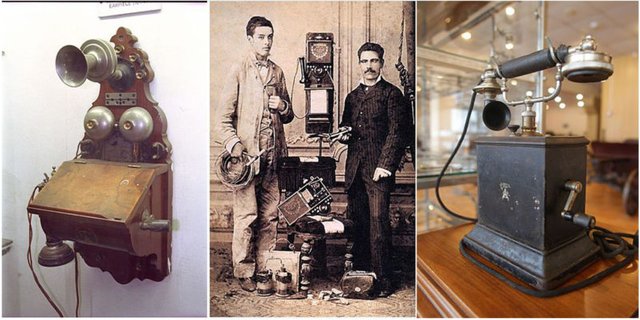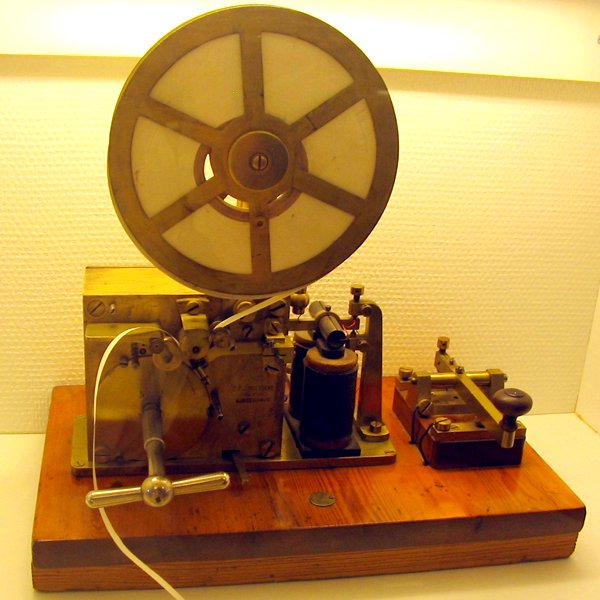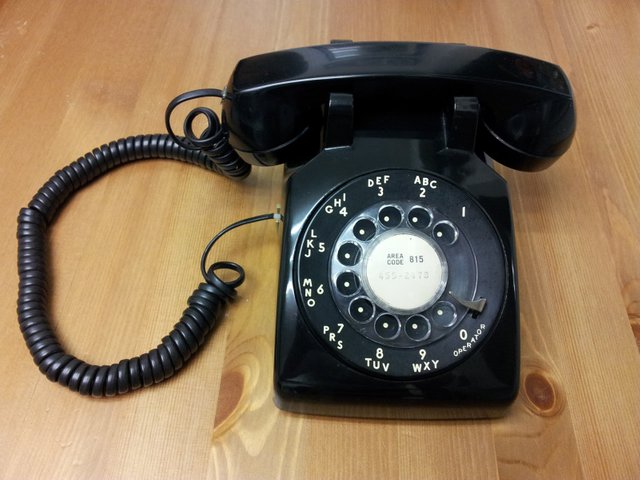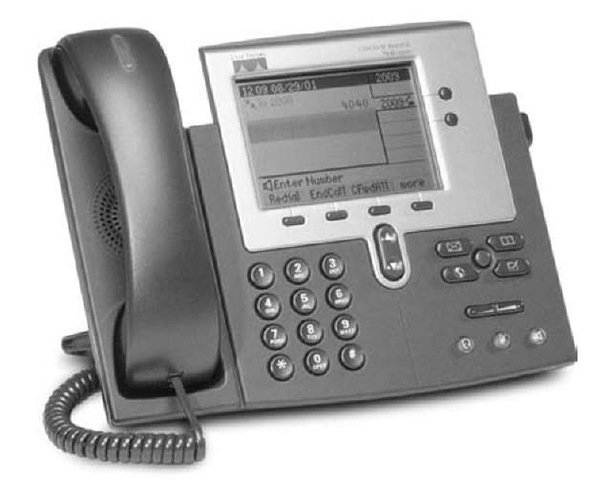
The telephone was the first device in history that allowed direct conversation over long distances. A telephone or telephone is a telecommunications device that connects two or more users to make a call to be heard directly. The telephone converts sound, usually and most effectively the human voice, into electronic signals, which are transmitted by cable and other communication channels to another telephone that reproduces the sound to the receiver.
Mechanical devices:-

Before the invention of electromagnetic telephones, there were mechanical acoustic devices for the transmission of speech and music at a greater distance than in the case of ordinary direct speech. The first mechanical telephones were based on the transmission of sound through pipes or other physical means. A canned phone has been known for centuries. It connects two membranes in a chain or tight wire that transmits sound from one membrane to another along the wire by mechanical vibration. One of the first known experiments was that of the British physicist and university scholar Robert Hooke from 1664-1685, who was assigned an acoustic string phone from 1667.
Electrical devices:-

The telephone was created as a result of the production and successive improvements of the electric telegraph. In 1804, the Spanish universal scientist Francisco Salva Campillo developed an electrochemical telegraph. The first working telegraph was built in 1816 by the English inventor Francis Ronalds and operated on static electricity.
The electric telegraph was first marketed by Sir William Fothergill Cooke and used on the Great West Railway in England. It ran 13 miles (21 km) from Paddington Station to West Drayton and was commissioned on April 9, 1839.
The invention of the telephone:-
The invention of the electric phone is often controversial and new controversies arise from time to time. Charles Bourseul, Innocenzo Manzetti, Antonio Meucci, Johann Philipp Reis, Alexander Graham Bell and Elisha Gray received the invention of the telephone. However, the patents of Alexander Graham Bell and Edison were economically decisive because they dominated telephone technology and were confirmed by US court rulings.
Alexander Graham Bell was the first to patent the telephone in 1876 as "a device for telegraphic transmission of songs or other sounds". Italian-American inventor and entrepreneur Antonio Meucci also received an award from the U.S. House of Representatives for his telephone work.
Telephone exchange:-
The main users of the electro telegraph were post offices, railway stations, major government centers (ministries), stock exchanges, very few national newspapers, major international companies and the wealthy. The telegraph exchanges operated mainly in the form of branch offices and on a forward basis. Although telephones were already in use before the invention of the telephone exchange, their success and economic operation would be impossible with the scheme and structure of today's telegraph systems.
The switchgear was conceived by the Hungarian engineer Tivadar Puskás (1844-1893), working for Thomas Edison on a telegraphic switchboard. Before the invention of the telephone exchange, telephone pairs were connected directly to each other, mainly to connect the house to the owner's business. The control panel offers a telephone service for a small area. Connects individual subscriber lines in case of calls between them, manually by operators or automatically by machine exchange. This allowed participants to call each other at home, in a store or in public places. As a result, telephony has become an accessible and convenient means of communication for many purposes and has given impetus to the creation of a new industrial sector.
On November 3, 1877, Coy applied for and received a franchise application from the Bell Telephone Company for New Haven and Middlesex counties. Coy and Herrick P. On January 15, 1878, Frost and Walter Lewis founded the New Haven District Telephone Company, which provided the capital.
The control cabinet built by Coya was built on the basis of the source of care screws, kettle lid handles, and wire'. According to company records, all office furniture, including the head office, was worth less than forty dollars. While 64 users could connect to the control panel, only two calls could be made at a time and six calls had to be made for each of them.
The New Haven District Telephone Company went live with only 21 subscribers paying $1.50 a month. However, until 21 February 1878, when the company's first telephone directory was published, fifty participants registered. Most of them are companies and telephone directories such as doctors, police and post offices; only eleven apartments were registered, four of them for people associated with the company.
The New Haven District Telephone Company grew rapidly and was reorganized several times during the early years. Until 1880 Bell Telephone Company gave the company the right to operate throughout Connecticut and Western Massachusetts. When the company developed in 1882, it changed its name to Connecticut and New South England for the first time. On April 23, 1965, the site of the first telephone exchange was announced as a national historical monument.
20th-century developments:-

By 1904, more than three million phones in the U.S. had been connected by a manual exchange. Until 1914. The United States was the world leader in call density and more than twice the trend compared to Sweden, New Zealand, Switzerland, and Norway.
The most popular and durable physical style of telephone was introduced in the early 20th century, connecting the receiver directly to the line, while the transmitter was inductively coupled to the local battery power supply. The docking transformer, battery, and ringtone were housed separately from the desktop kit. The rotary base switch interrupts the mains power by disconnecting the lines 1 to 10 times per digit several times, and the hook switch (in the center of the circuit diagram) permanently disconnects the line and battery from the transmitter when the handset is on the base station.
Since the 1930s, the telephone base station has also included a bell and an inductor coil, so there was no need for a separate bell box. Individual calls from subscribers were made with central batteries, not local batteries, which required regular maintenance. In the next half century the network behind the telephone became larger and more efficient, and after adding the rotary switch the instrument itself changed little until in the 1960s the key beeping began to replace the rotary switch.
Digital telephones and voice over IP:-

The invention of the transistor in 1947 radically changed the technology of telephone systems and long-distance transmission networks. With the development of electronic switching systems in the 1960s, telephony gradually evolved into digital telephony, improving network capacity, quality, and cost. Real-time data in computer networks, forming an Internet telephony (IP) field, also known as VoIP (Voice over Internet Protocol).
Since January 2005, up to 10% of subscribers in Japan and South Korea have switched to this digital telephone service. Since 2006, many VoIP companies have been offering services to their customers and businesses.
Good article sir, I have upvote and I am following you, please follow me back
Downvoting a post can decrease pending rewards and make it less visible. Common reasons:
Submit
Hey @naik18, nice post and very interesting. Right now we are living in a technological word, with a lot of advances in the science area... and sometimes we forget the importance of the big inventions and how and how much they have developed
Downvoting a post can decrease pending rewards and make it less visible. Common reasons:
Submit
yes, @cocolefleur you are right we never forget that hard work of the big inventions.
Downvoting a post can decrease pending rewards and make it less visible. Common reasons:
Submit
Congratulations @naik18! You have completed the following achievement on the Steem blockchain and have been rewarded with new badge(s) :
Click on the badge to view your Board of Honor.
If you no longer want to receive notifications, reply to this comment with the word
STOPDo not miss the last post from @steemitboard:
Downvoting a post can decrease pending rewards and make it less visible. Common reasons:
Submit
Good article, upvote and follow me, I Upvoted and followed you
Downvoting a post can decrease pending rewards and make it less visible. Common reasons:
Submit
Congratulations @naik18! You received a personal award!
You can view your badges on your Steem Board and compare to others on the Steem Ranking
Downvoting a post can decrease pending rewards and make it less visible. Common reasons:
Submit